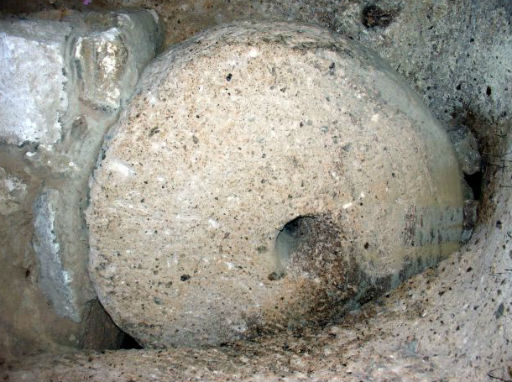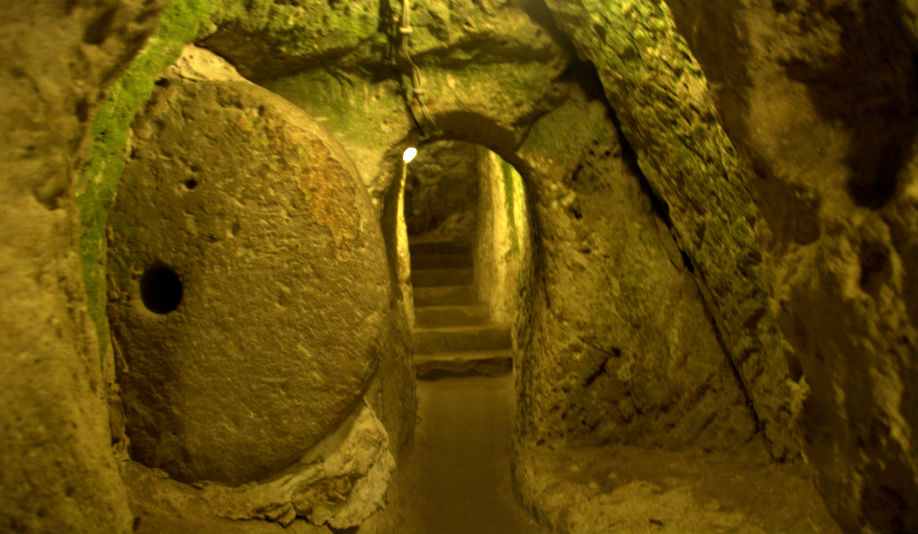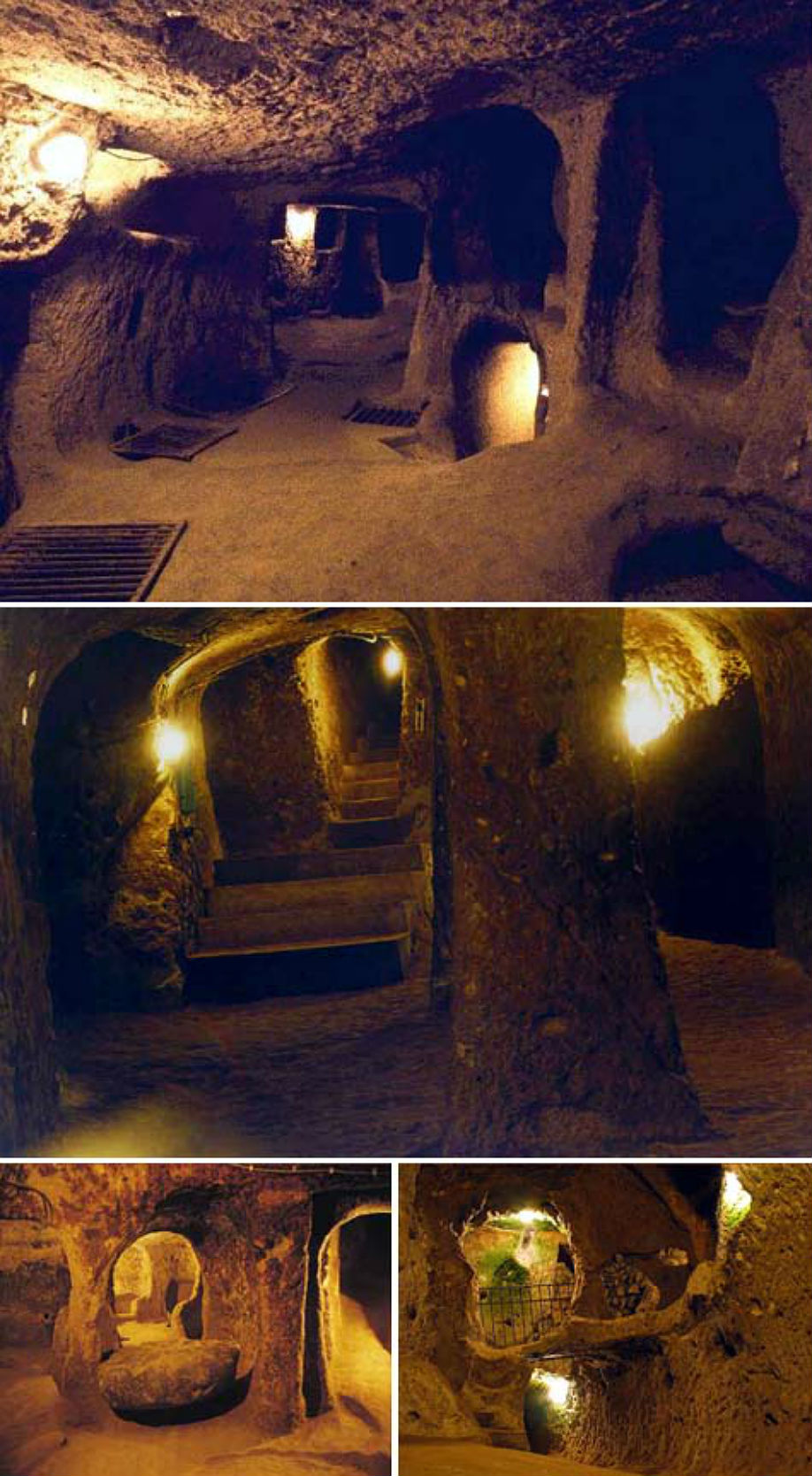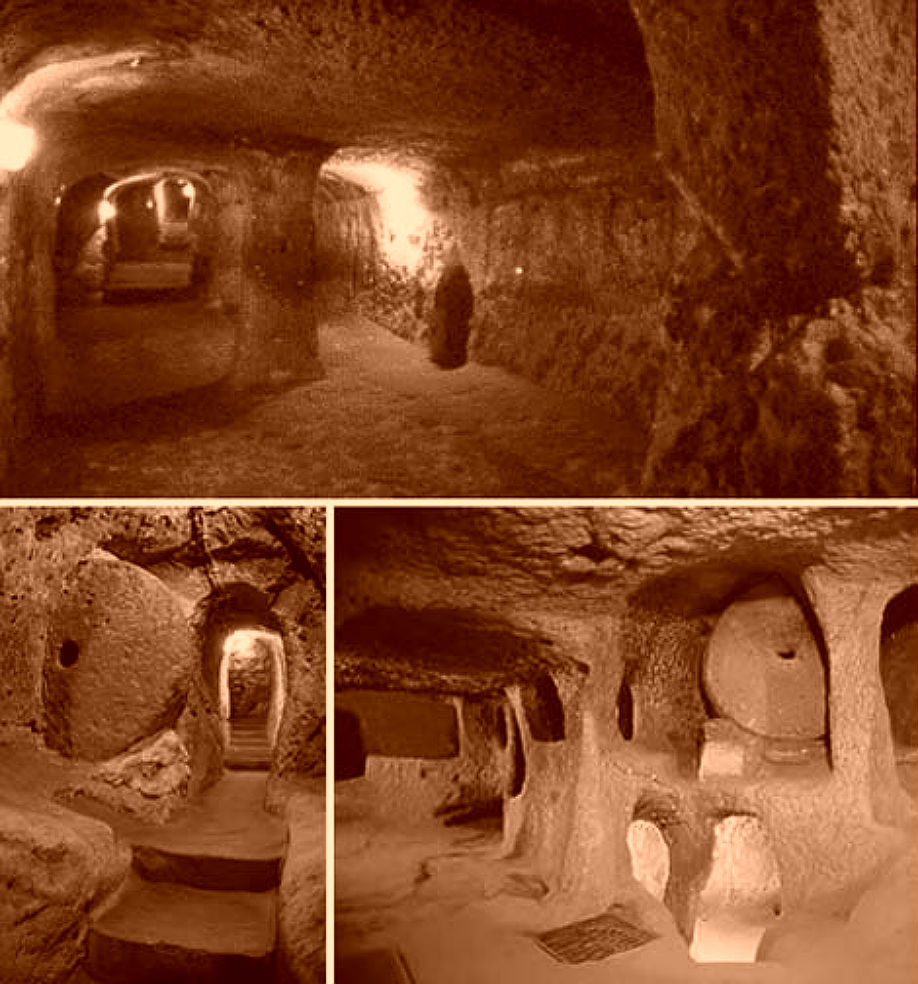Derinkuyu Underground City is an ancient multi-level underground city of the Median Empire in the Derinkuyu district in Nevşehir Province, Turkey.
Extending to a depth of approximately 60 m, it was large enough to shelter approximately 20,000 people together with their livestock and food stores.
It is the largest excavated underground city in Turkey and is one of several underground complexes found across Cappadocia.

One of the heavy stone doors. They have a height of 1–1,5 m, 30–50 cm in width and weigh 200–500 kg. The hole in the centre can be used to open or close the millstone, or to see who is outside.
It was opened to visitors in 1969 and to date, about half of the underground city is accessible to tourists. The underground city at Derinkuyu could be closed from the inside with large stone doors. Each floor could be closed off separately.
The city could accommodate up to 20,000 people and had all the usual amenities found in other underground complexes across Cappadocia, such as wine and oil presses, stables, cellars, storage rooms, refectories, and chapels. Unique to the Derinkuyu complex and located on the second floor is a spacious room with a barrel vaulted ceiling. It has been reported that this room was used as a religious school and the rooms to the left were studies.
Between the third and fourth levels is a vertical staircase. This passage way leads to a cruciform church on the lowest (fifth) level.
The large 55 m ventilation shaft appears to have been used as a well. The shaft also provided water to both the villagers above and, if the outside world was not accessible, to those in hiding.
History
First built in the soft volcanic rock of the Cappadocia region, possibly by the Phrygians in the 8th–7th centuries B.C according to the Turkish Department of Culture, the underground city at Derinkuyu may have been enlarged in the Byzantine era. During the Persian Achaemenid empire the city was used as a refugee settlement. There are references to underground refugee settlements built by the Persian king Yima in the second chapter of the Zoroastrian book Vendidad. Therefore many scholars believe that the city may have been built by the Persians. The city was connected with other underground cities through miles of tunnels.
Some artifacts discovered in these underground settlements belong to the Middle Byzantine Period, between the 5th and the 10th centuries A.D. It is speculated that the number of underground settlements, generally used for taking refuge and for religious purposes, increased during this era.
Derinkuyu Underground City, Cappadocia,





Fascinating and a little daunting to clamor around through narrow passages uner the earth. Only visited one of the underground cities and it only went down about 4 stories, but I understand there are more than 20 in the area and some go as deep as 8 stories. Don't miss visiting one of them
This place redefines the troglodyte experience. We had an excellent guide and a wonderful time. Beautiful
This is a must. Make sure you go with a tour guide, so that they can explain the life in this underground city. It is truly remarkable how people lived there and hid from prosecution. Very beautiful and interesting.
We arrived in our own rental car at about 2pm and the crowds weren't too bad. We didn't have a guide, but did have several people offer. I have a tendency too get nervous in small places, but this really wasn't too bad for me. It was cold, which helped, along with the lack of crowds. We spent a little…
What you will actually see is narrow stone tunnels and steps that go down the equivalent of about 5 stories. There are also 'rooms'–but nothing to actually see besdides more areas carved out of stone. The entrance fee, 15 TL per person is OK, but if you want to know what you are looking at, the 'guide' charges extra–he started…
that underground city was just stunning. i was amazed by how people back then were able to build a complete city underground at a time when there was no hi tech or building tools & equipments. it goes 8 floors deep underground, & divided into rooms, kitchens, and other areas including a school. it has these maze tunnels and steps…
Derinkuyu underground city is absolutely one of the things you must see to get the `total` impression of fabulous Capadoccia! You are going 60m underground through narrow tunnels, see the capability of our human ancestors to manage to survive in the most dangerous and severe situations and what impressed me so much was the way they managed the supply of…
This is a rather fresh and new looking smaller town nearby the Cappadocian sights/sites. Shopping there is actually pleasant, the river and surrounding park are delightful on a sunny days (as was our time there). There are numerous coffee shops and cafes that are delightful, and there are a variety of shops selling local handicrafts, especially pottery and ceramics.
This is an amazing sight. Not good for anyone with claustrophobia as you desend many levels into the earth through small tunnels. I hit my head several times in spite of trying to be careful. I recommend that if you are tall, wear a hat. It will help soften the blows! It's an outstanding sight that should not be missed.
This was the first stop of our south Cappadocia tour. When we arrived, around 10:30 AM, there wasn't much of a crowd and our guide let us in quick. We were a group of 3 couples. Two people had to leave 5 minutes in. If you're claustrophobic, have breathing difficulties, or have related allergies then you won't be able to…